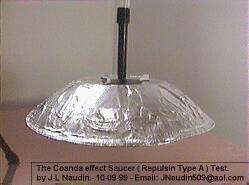

The Coanda Saucer
or the "Repulsin
type A" test
By Jean-Louis Naudin
created on October 9th, 1999 - JLN
Labs - Last update October 10th, 1999
The Coanda Effect has been discovered in1930 by the Romanian aerodynamicist Henri-Marie Coanda (1885-1972). He has observed that a steam of air (or an other fluid) emerging from a nozzle tends to follow a nearby curved surface, if the curvature of the surface (or angle the surface makes with the stream) is not too sharp.
The Coanda
Effect works with any of our usual fluids,
such as air at usual temperatures, pressures and speeds. The
Coanda effect is used in the Schauberger's Repulsin (type A)
for increasing significantly the main thrust generated by the
implosion effect in the vortex.
When the main electric engine is started,
the Coanda effect begins to create a differential aerodynamic
pressure between the outer and the inner surface of the primary
hull. At a higher speed, the vortex chamber becomes a kind of
high electrostatic generator due to the air particles in high
speed motion acting as an electrical charges transporter...
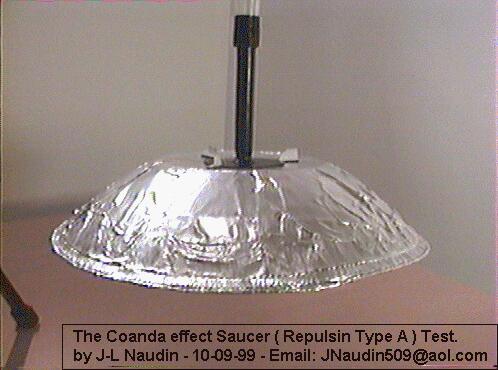

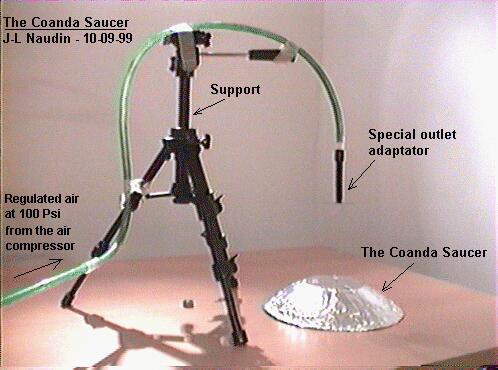
The experimental setup and test results :
The Coanda Saucer (250 mm diam, 45mm height) has been built with an aluminum sheet. The surface doesn't need to be smoothless, the presence of some surface irregularities can help to improve the coanda flow above it, because this generates tiny vortexes along the arcuate surface. A flat surface (110mm diam) must be set on the top of the saucer, this is the expanding area of the radial air flow. Three small stabilizers made with cardboard have been fixed on the top of the saucer (see the picture below).
The "special outlet adaptator" used for generating the coanda effect is a simple plastic tube ( inner diam : 9mm, lenght: 90mm ) with a simple plastic disc ( 50mm diam, with a 9mm hole in the middle ) glued to this tube. This adaptator allows the air flow to expand radialy along the top surface of the saucer. The green tube (in the picture above) is used for the regulated air flow ( 100 Psi, 7 Bar ) generated by the electrocompressor (model Walmec OL230).
When the compressed air is sent, take the Coanda saucer and approach it to the air outlet. You will notice that, in spite of the high pressure flow output, the Coanda Saucer remains sticked by the depression generated above the surface by the Coanda effect.
| The radial air pressure required for lifting 1kg with the Coanda Effect is about 1,4 kg/cm2 |
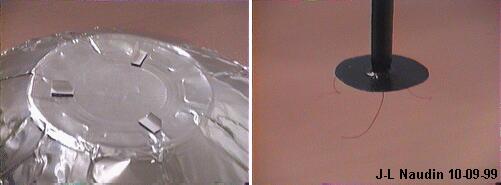
The left picture above shows the
small stabilizer placed a 120 degres,
the right picture shows the air outlet adaptator.
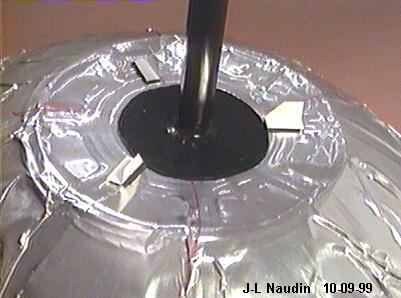
See the video of the Coanda Saucer in action :
RealVideo of the Coanda Saucer in action (233kb)
( if you don't have the RealPlayer 5.0, you may download it freely at : http://www.real.com/products/player/ )
The Coanda effect can also be used in an Electro-HydroDynamics (EHD) device . In this case, the device will use High Voltage with special shaped electrodes. The differential pressure in the medium ( aether) between the upper surface and the inner surface creates a mechanical force which propels the device in one direction.
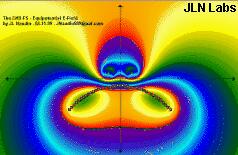
The most interesting thing to notice is that there is a direct conversion of electrostatic energy into kinetic energy with no moving parts. The motion of the medium around the ship can be used for producing electrical energy and self-sustaining the primary effect. In vacuum space the surrounding plasma and the aether flow can be maintained in a closed path with some special shaped electrode, so it is possible to use an enhanced EHD ship with a plasma flow embedded in a vortex ( which uses the implosion effect ala Schauberger ) as a space ship.
See the EHD Flying saucer v1.0
![]() Email : JNaudin509@aol.com
Email : JNaudin509@aol.com
Return to the Vortex technologies page